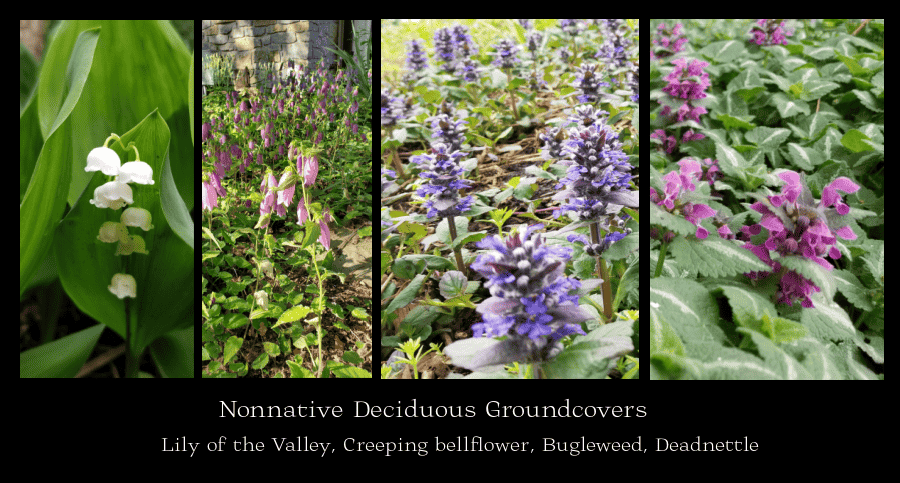Shade groundcovers are suited best for areas under, well, shade. But what are groundcovers exactly? Many new gardeners are not sure about the role or purpose of groundcovers in the garden let alone for shade. Shade is any area under trees, overhangs, or structures such as pergolas, which recieves less than 8 hours of direct sun per day. Shade groundcovers thrive with less sun, not more. I will discuss sun groundcovers next week.
There are many different kinds of shade groundcovers for the garden. They can be annual or perennial, or even woody (some type of shrub). There are natives and nonnatives. Some are grown more for their flowers and some for their foliage. And some have wildlife or pollinator benefits. Picking shade groundcovers is an important step when designing a shade landscape or garden.
What is the purpose of a groundcover? Groundcovers are plants or materials which cover bare soil. The soil may be bare due to dense shade, compaction, or other impediment. Large areas under trees are prime places for living groundcovers because the trees’ fine roots take up the same soil horizon as turf grass. Therefore, planting a more deep rooted groundcover can hold the bare soil top better than turf.
Annual and Perennial Shade Groundcovers
I will divide the categories of shade groundcovers into annual and perennial, and shrub. Also, into native and non-native subcategories. Separating them in this way will help you find the right groundcover for your garden. Remember, right plant, right place! There are a number of different groundcovers for various areas of the country, so as always, I will focus on the Central Great Plains region, Zones 5 to 6b.
Why plant annual groundcovers? If the purpose of a groundcover is to keep bare soil covered, then what about winter? Annual groundcovers usually go into an area of higher visibility, such as along roads, walkways, or buildings. These shade groundcovers fill the space and provide benefits of color or flowers for pollinators.
Perennial groundcovers hold the soil better than annuals, and do not require mulch to be put down past the initial planting. Once their roots fill in, the only maintenance they require is yearly cutback or pruning. Even the evergreen ones thrive on a yearly haircut.
Annual Groundcovers for Shade
There are not very many in this list, at least not for the Central Great Plains. Some of the nicest annual groundcovers prefer full sun, and will only stretch and grow thin in the shade. But 2 do well, in both sun and shade.
- Sweet Potato Vine cultivars – most of the cultivars of annual sweet potato vine can handle both sun and shade equally. Selections can have purple, green, chartreuse, or variegated leaves. The vine fill in quickly, especially in hot summers, stretching out 10 to 20 feet from the original plant.
- Spurflowers (Plectranthus) – has soft, fuzzy leaves which can be green, silvery, variegated, or almost black. There are flowers, usually lavender or white in color which are attractive to bumblebees and hummingbirds.
Native Perennial Groundcovers
The list of native shade groundcovers is not too extensive, but there are a number of great plants for the shade garden. These are best suited for our region and are adapted more to our heat and high humidity in the summer than many of the nonnative groundcovers. Our native bees, butterflies, and other insects are also adapted to these plants.
- Wild ginger (Asarum canadense) – grows 3 to 6 inches high, and will slowly fill in any dry, rocky, shady areas under trees or rock outcrops. The roots when disturbed smell of ginger, though it is a poor substitute for tropical ginger. Flowers are reddish brown and hidden under the foliage.
- Virginia waterfleaf (Hydrophyllum virginiana) – one of my favorite groundcovers for shade. It has water-splotched variegations on the foliage and blooms with bright pink or white flowers which bees love. It grows 6 to 12 inches tall and fills in quickly in wet or dry areas.
- Woodland phlox (Phlox divaricata) – another favorite woodland groundcover. Woodland phlox flowers can be pink, purple, lavender, blue, or white and are frequented by long-tongued bees, butterflies, flower flies, and early hummingbirds. It has a long bloom time too, up to 10 weeks in spring. Woodland phlox grows 4 to 8 inches tall and spreads quickly through rhizomes and by seed.
- Solomon’s Seal (Polygonatum species) – with the advent of new cultivars, Solomon’s seal has become a popular addition to the shade garden. It grows quickly, is drought resistant, and has bell shaped flowers which are frequented by bumblebees. Solomon’s seal grows 10 to 14 inches tall.
- Parlin’s Pussytoes (Antennaria parlinii) – most of the pussytoes prefer full sun, but Parlin’s can take some shade and be quite happy. The leaves are silvery green and it has small, pinkish flowers which are utilized by small bees and flower flies in early spring. It grows 3 to 8 inches tall and spreads moderately.

Nonnative Deciduous Groundcovers
I have to sort these into evergreen and deciduous, because there are a lot of nonnative groundcovers for the garden. Some are very invasive and I will have a list of those to avoid below. Most of these, while providing some pollen or nectar to insects, do not provide any other benefits to wildlife.
- Bugleweed (Ajuga reptans) – a low growing, shiny leaved groundcover. Ajuga has bright blue flowers in late spring to early summer or leaves which can be bronzed green, green, or variegated. It grows 3 to 6 inches tall and is drought tolerant.
- Deadnettle (Lamium species) – it has variegated leaves which are soft. A member of the mint family, deadnettle prefers the shade and will grow 3 to 6 feet out a year. It grows 3 to 12 inches tall. Flowers are purple or pink usually, and are attractive to bumblebees.
- Creeping Bellflower (Campanula species) – these can form a very dense mat of leaves, which prevents weeds from growing through. They can be somewhat aggressive, but I have not yet seen any invasive tendencies. Flower color can vary a lot. The plants grow 2 to 8 inches tall.
- Lily of the Valley (Convallaria majalis) – this little groundcover has very fragrant flowers, but the plant is poisonous, so it should not be planted where kids play. The flowers are little white bells. It grows 4 to 8 inches tall and spreads quickly through rhizomes.

Nonnative Evergreen Groundcovers
- Lilyturf (Liriope species) – there a few different species of these, some spreading faster than others. Leaves can be dark green or variegated. They do have spikes of bright lavender flowers, which flies mostly go to. It looks like a grass, but prefers to be just cut back in early spring. It grows 6 to 12 inches tall.
- Japanese pachysandra (Pachysandra terminalis) – this evergreen groundcover rarely even needs a trim in spring, except to remove damaged leaves. It grows 6 to 12 inches tall and spreads quickly through rhizomes. Flowers are small and yellow and attract flies.
- Periwinkle (Vinca minor) – in the Northeastern US, periwinkle has escaped cultivation and is somewhat invasive in native landscapes. This is mainly because it has no natural predators, but also because the leaves are evergreen with a waxy cuticle which resists herbicides. It grows 3 to 10 inches tall and can have pink, white, or purple flowers. It does spready quickly and prefers to be mowed to the ground in early spring.

Invasive Groundcovers to Avoid
I would suggest not planting any of these either anywhere in your landscape as their potential damage to the natural landscapes is great. Already here in Northeast Kansas, we have a problem with wintercreeper and Japanese honeysuckle, as they spread through woodlands and are only controlled by fire.
- Wintercreeper (Euonymus fortunei) – a very aggressive and nearly impossible to kill evergreen groundcover. Sounds like a dream right? But it chokes out native flora in woodlands and savannah, and can suffocate and kill trees too.
- Ground Elder (Aegopodium podagraria) – a tough, drought tolerant, deciduous groundcover which is very invasive. It is very tolerant of herbicides, and glyphosate will not kill it. It spreads very aggressively.
- Japanese honeysuckle (Lonicera japonica) – has sweet smelling flowers but wraps itself around trees and other plants, suffocating them. The stems are like wire when young and very fibrous as they age. It grows very fast.

Woody Shade Groundcovers
There are not very many shrubby shade groundcovers, but the few we have are worth growing in the garden. I like to use woody groundcovers when you need more height to fill in a space than what you may get with perennials or annuals.
- Coralberry (Symphoricarpos orbiculatus) – actually more of a woodland edge plant than a true shade lover, coralberry will grow in dappled to part shade. It grows 2 to 4 feet tall with small pink flowers in midsummer, followed by unpalatable dark pink or red berries in autumn. The plant itself is a host for the snowberry clearwing moth which looks like a hummingbird moth.
- Virginia sweetspire (Itea virginica) – some might call it more of a thicket former than a groundcover, but it can be both. It grows 2 to 8 feet tall and spreads aggressively through rhizomes. There are cultivars which stay shorter and are more like true shade groundcovers. It can also grow in sun or shade. Sweetspire has long drooping flowers in spring which are very fragrant and attracts a lot of bees. It even has pretty fall color.
- Oregon Grape-Holly (Mahonia species) – there are 2 species of Mahonia which are used, one a low growing true groundcover and one a thicket former. But they both could be called shade groundcovers as they both love the shade. Not a true holly, they have leaves which are very prickly and bright yellow flowers in spring. Grape-holly grows 3 to 8 feet tall and spreads moderately.

Conclusion
Shade groundcovers are needed for areas under trees and overhead structures where turfgrass and other plants refuse to grow. Plan to put some of these groundcovers to work in your gardens today.
Happy planting!




